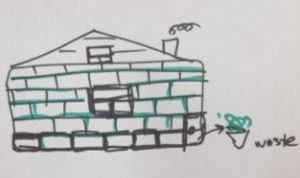This is a cross-post. The original is
here.
Join the 2017 LeSS Conference in London to find more discussions
like this.

Large Scale Scrum (LeSS). It is the framework for scaling agile development, done by multiple teams, as they work on same product and work for a single Product Owner. In order to be effective, LeSS requires organizational descaling that means simplification/flattening of organizational design.
What is Organizational Design? To understand it better, let’s look for analogy in construction industry. What is required to erect a building? In our analogy, we shall stay simple: bricks (foundation block) and cement (connective material that holds bricks together).
Imagine two buildings: Building A and Building B.
Building A uses brick as its main foundation block. In fact, when looking at the building’s facade, the most prevalent object, caught by a naked eye, is a brick. Bricks are positioned next to one another, with just enough cement in-between to glue them strongly together. There is no excess of cement anywhere: the connection layer is very thin/lean.

Architectural design of building A is simple and flexible: the structure is flat (one-story high) and it sits on strong foundation, also made of brick. Because of its design, architectural adjustments are possible in various sections of the building, independently, with little additional labor. Due to such modular structure, the building can be expanded laterally, just by adding more bricks to the wall. Of course, due to its flat structure, the building is also very stable and can withstand a strong wind, flood or an earthquake: practically nothing can be shaken off or washed off the building.
When waste is produced inside the building, it becomes noticeable immediately. Waste disposal is also very simple: it does not require complex chutes or automated waste ‘packaging’ systems. Waste removal can be mostly done manually, by building residents. Any necessary supplies (e.g. food, water, furniture, other materials) can be easily delivered to any building area, without the need of advanced technology or mechanics.
Finally, building inspection and maintenance is a very easy process, because of flat structural design: foundation, walls and floor assessment – all can be performed with a naked eye; corrections can be done timely and efficiently.
This is what building A looks like:


 by
by  by
by 


 by
by  by
by  by
by